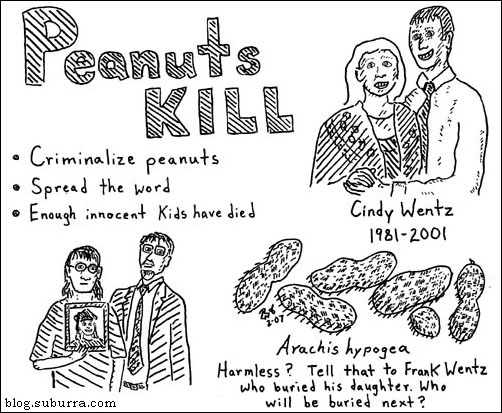Posted: February 13th, 2008 | Filed under: drugs, ecstasy, media bias | 50 Comments »

Drug War Logic
This cartoon is based on national news coverage of an ecstasy (MDMA) death in 2002 and the anti-E government ads that followed. E kills roughly 3-9 Americans a year. Peanuts kill roughly 50-100 Americans a year. The death rate of first-time ecstasy users has been estimated by one study to be between .002% to .05%. Comparatively, .1% of Americans are estimated to have a life-threatening peanut allergy.
To read about golfing on E go to this post.
Source
- Robert Arthur, You Will Die: The Burden of Modern Taboos (2007). LINK
Posted: February 12th, 2008 | Filed under: Uncategorized | Comments Off on This Blog Is Spread
 Narco Polo’s cartoons can now also be found at DoseNation.com. DoseNation is a collaborative blog covering all aspects of modern drug culture. Already posted cartoons at DoseNation include “Why They Hate Us” and “Healthy Drug Users vs. Obese Narcophobes.”
Narco Polo’s cartoons can now also be found at DoseNation.com. DoseNation is a collaborative blog covering all aspects of modern drug culture. Already posted cartoons at DoseNation include “Why They Hate Us” and “Healthy Drug Users vs. Obese Narcophobes.”
Posted: February 1st, 2008 | Filed under: cocaine, DEA, drugs, heroin | 1 Comment »

Would We Stand For It?
1. In 1982 Ronald Reagan launched his disastrous war on drugs with the words, “We’re taking down the surrender flag that has flown over so many drug efforts. We’re running up a battle flag.”
2. In 2000 there were an estimated 85,000 alcohol related deaths in the United States alone. In 2005 there were 40,000 deaths from alcohol poisoning (alcohol overdose) in Russia alone.
3. Destroying drug crops in foreign lands was an idea conceived by the Reagan administration. Reagan hired mercenaries to clear the coca fields of poor Peruvian farmers with weed whackers. This was a farce considering coca grows naturally in Peru in valleys the size of Massachusetts. America is now waging this vegetative vendetta against poppies in Afghanistan.
4. America’s next plan was to aerially dump herbicides over the South American countryside. While officially targeting coca these toxins kill all plant life – including subsistance crops – while poisoning the environment and the local residents. This technique is still used in South America as a part of Plan Colombia. Afghanistan has understandably refused to allow the United States to dump herbicides on its countryside.
5. Another part of Plan Colombia is to pay farmers to plant crops other than coca. Like the previous two tactics, this has been comically ineffective as Bolivian farmers who switched to ginger learned when they found themselves, “up to their asses in ginger,” and nobody willing to buy it.
6. America uses its full diplomatic weight and financial power to bully other countries against liberalizing their drug laws. In 2006 America stopped Mexico’s legislation to legalize small amounts of drugs with a closed door meeting. The American position was that drug liberalization by Mexico would lead to narco-tourism for Americans. (America has an officer in most major foreign embassies charged with keeping Washington informed of any liberalization of drug policies.) How much America spends to coerce other countries to keep prosecuting their citizens is rarely revealed to the American public.
7. For thousands of years opium had been smoked as medicine in South Asia and coca has been chewed for sustenance in South America with miniscule deleterious effects. However, the American media portrays Afghanistan as a cesspool of addiction due to its easy access to opium. In articles such as Newsweek’s “Flowers of Destruction” and “Harvest of Treachery” moderate use of the drug is ignored and dysfunctional addicts who constitute a microscopic percentage of the population are highlighted. (The fact that the drug war drives people to use harder versions of the drug is always ignored. This recently occurred in rural Laos where an opium crackdown precipitated by immense Western pressure drove many tribespeople to heroin.)
More on Plan Colombia can be found in a Nation article, LINK, and at Wikipedia, LINK. The ongoing billion dollar program has killed a lot of flora, provoked massive amounts of bloodshed with American provided weaponry, and caused deep American resentment. It has not affected cocaine prices in the United States.
Sources:
- “Alcohol Deaths Falling as Quality of Booze Climbs,” Moscow Times, 29 Jan. 2008. LINK courtesy of ViceSquad.
- Robert Arthur, You Will Die: The Burden of Modern Taboos (2007). LINK
- Mike Gray, Drug Crazy (1998). LINK
- Phillip Knightley, “What Went Wrong? The Drugs World War: Part Two,” Independent (London), 1 Feb. 1998.
- “Laos’s Opium Ban,” Economist, 13 Aug. 2005.





